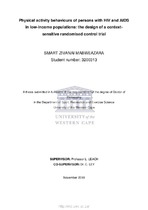| dc.description.abstract | The Human immunodeficiency virus (HIV) and acquired Immunodeficiency syndrome (AIDS) are serious health issues that continue to affect many nations. Specifically, the sub-Saharan African region has the highest prevalence of HIV and AIDS worldwide. Africans living in informal settlements or townships have the highest prevalence of HIV in South Africa. Persons of low socioeconomic status (SES) in general become socialised into unhealthy behaviours and risk factors at early ages, and experience poor health outcomes. Physical activity (PA) is one cost-effective, non-pharmacological approach that has been reported as conjunctive therapy for HIV to effectively address these impairments.
Aim: The aim of the study was to develop a contextualized intervention that promotes PA among persons living with HIV and AIDS (PLWHA) of low SES.
Methods: A mixed methods approach was used. Studies included (1) a systematic review which assessed (a) specific and useful intervention techniques that were previously used in successful PA interventions (b) relevant behaviour change theories used to develop the intervention content, (2) a narrative review which examined the available literature on PA, social support and SES with a view to inform the design of effective PA interventions for PLWHA of low SES, (3) a cross sectional study which aimed at determining if age, body weight, height, gender, waist-to-hip ratio (WHR), educational attainment, employment status, CD4+ cell count, and body mass index (BMI) could predict overall PA among PLWHA of low SES in Cross roads Township in the Western Cape Province, South Africa (4) a cross-sectional study which (a) examined the PA profile of PLWHA of low SES based on PA domains and intensity and (b) determined whether employment status and level of education can predict PA among PLWHA of low SES in Cross roads Township in the Western Cape Province, South Africa (5) a mixed methods study which investigated the benefits and barriers of PA for HIV-positive women of low SES using the Exercise Benefits/Barriers Scale and focus group discussions, (6) a study which sought to develop a contextualised intervention for promoting PA among PLWHA of low SES and (7) a crossover study conducted at a community centre caring for HIV positive Black African Xhosa-speaking women of low SES in Nyanga Township in the Western Cape Province in South Africa.
Results: The systematic literature review showed that the following techniques, namely, ‘provide feedback on performance’, ‘goal setting (behaviour)’, and ‘plan social support/social change’ were the most frequently used behavioural change techniques in interventions focusing on promoting PA for the management of chronic diseases amongst individuals of low SES. The review also showed that the Transtheoretical model of behaviour change and the Social Cognitive theory were the common theoretical frameworks of most study interventions. | en_US |

